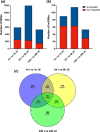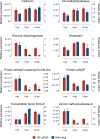Transcriptional response of Wolbachia-transinfected Aedes aegypti mosquito cells to dengue virus at early stages of infection
- PMID: 35006065
- PMCID: PMC8895618
- DOI: 10.1099/jgv.0.001694
Transcriptional response of Wolbachia-transinfected Aedes aegypti mosquito cells to dengue virus at early stages of infection
Abstract
Mosquito-borne flaviviruses are responsible for viral infections and represent a considerable public health burden. Aedes aegypti is the principal vector of dengue virus (DENV), therefore understanding the intrinsic virus-host interactions is vital, particularly in the presence of the endosymbiont Wolbachia, which blocks virus replication in mosquitoes. Here, we examined the transcriptional response of Wolbachia-transinfected Ae. aegypti Aag2 cells to DENV infection. We identified differentially expressed immune genes that play a key role in the activation of anti-viral defence such as the Toll and immune deficiency pathways. Further, genes encoding cytosine and N6-adenosine methyltransferases and SUMOylation, involved in post-transcriptional modifications, an antioxidant enzyme, and heat-shock response were up-regulated at the early stages of DENV infection and are reported here for the first time. Additionally, several long non-coding RNAs were among the differentially regulated genes. Our results provide insight into Wolbachia-transinfected Ae. aegypti's initial virus recognition and transcriptional response to DENV infection.
Keywords: Aedes aegypti; Wolbachia; dengue virus; differential gene expression; transcriptome.
Conflict of interest statement
The authors declare that there are no conflicts of interest.
Figures



Similar articles
-
Role of Vigilin and RACK1 in dengue virus-Aedes aegypti-Wolbachia interactions.mSphere. 2025 Jan 28;10(1):e0048224. doi: 10.1128/msphere.00482-24. Epub 2024 Dec 23. mSphere. 2025. PMID: 39714171 Free PMC article.
-
The effects of DENV serotype competition and co-infection on viral kinetics in Wolbachia-infected and uninfected Aedes aegypti mosquitoes.Parasit Vectors. 2021 Jun 9;14(1):314. doi: 10.1186/s13071-021-04816-0. Parasit Vectors. 2021. PMID: 34108021 Free PMC article.
-
Interaction of the Wolbachia surface protein with a novel pro-viral protein from Aedes aegypti.mBio. 2025 Jan 8;16(1):e0148624. doi: 10.1128/mbio.01486-24. Epub 2024 Nov 22. mBio. 2025. PMID: 39576110 Free PMC article.
-
A comprehensive review of Wolbachia-mediated mechanisms to control dengue virus transmission in Aedes aegypti through innate immune pathways.Front Immunol. 2024 Aug 8;15:1434003. doi: 10.3389/fimmu.2024.1434003. eCollection 2024. Front Immunol. 2024. PMID: 39176079 Free PMC article. Review.
-
Mission Accomplished? We Need a Guide to the 'Post Release' World of Wolbachia for Aedes-borne Disease Control.Trends Parasitol. 2018 Mar;34(3):217-226. doi: 10.1016/j.pt.2017.11.011. Epub 2018 Jan 23. Trends Parasitol. 2018. PMID: 29396201 Review.
Cited by
-
E2 Ubiquitin-Conjugating Enzymes Regulates Dengue Virus-2 Replication in Aedes albopictus.Microorganisms. 2024 Dec 5;12(12):2508. doi: 10.3390/microorganisms12122508. Microorganisms. 2024. PMID: 39770712 Free PMC article.
-
Wolbachia elevates host methyltransferase expression and alters the m6A methylation landscape in Aedes aegypti mosquito cells.BMC Microbiol. 2025 Mar 25;25(1):164. doi: 10.1186/s12866-025-03898-5. BMC Microbiol. 2025. PMID: 40128692 Free PMC article.
-
Recent Advances and Future Potential of Long Non-Coding RNAs in Insects.Int J Mol Sci. 2023 Jan 30;24(3):2605. doi: 10.3390/ijms24032605. Int J Mol Sci. 2023. PMID: 36768922 Free PMC article. Review.
References
-
- Liu-Helmersson J, Brännström Å, Sewe MO, Semenza JC, Rocklöv J. Estimating past, present, and future trends in the global distribution and abundance of the arbovirus vector Aedes aegypti under climate change scenarios. Front Public Health. 2019;7:148. doi: 10.3389/fpubh.2019.00148. - DOI - PMC - PubMed
Publication types
MeSH terms
Substances
LinkOut - more resources
Full Text Sources
Medical

